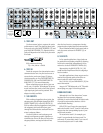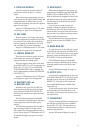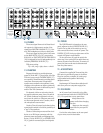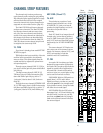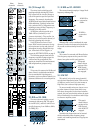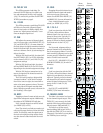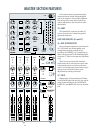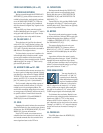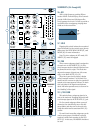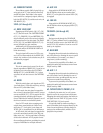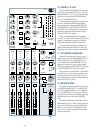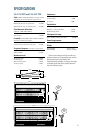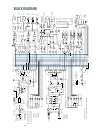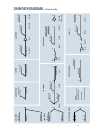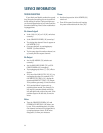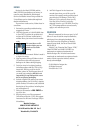25
60. SUBGROUP FADERS
These faders provide 10dB of gain fully up,
unity gain at the “U” label and are effectively
muted fully down. Each fader is the master
level control for a subgroup’s signal, affecting
both the SUB OUTS (8) and the main mix, via
L/R ASSIGN (59).
SOLO: (61 through 65)
61. RUDE SOLO LIGHT
Engaging any SOLO switch (39),(47),(52)
or (57) has this result: The CONTROL ROOM
OUT (11), PHONES (18) and METERS (54),
which ordinarily receive the main mix signals,
will instead receive the solo signal. The MAIN
OUTS (12) (16) and MONO MAIN OUT (14)
are not affected by a solo condition.
Additionally, an LED associated with the
solo switch and the RUDE SOLO LIGHT will
blink obnoxiously.
The solo signal will be mono in PFL or ste-
reo in AFL, as determined via the MODE (63)
switch. Any number of solo switches may be si-
multaneously engaged.
62. LEVEL
This is the master level control for all solo
signals, regardless of MODE (63). It can be set
as desired, as it only affects the CONTROL
ROOM OUT (11) and PHONES (18). It does
not affect the solo levels sent to the METERS
(54).
63. MODE
With this switch down, solo signals are PFL
(pre-fader listen). With this switch up, solo sig-
nals are AFL (after-fader listen).
In PFL mode, the solo signal is tapped be-
fore a circuit’s associated level control (except
aux return SOLO (52)). PFL is popular for live
sound applications; providing quick inspec-
tions of individual or multiple channels, even if
their level controls are turned fully down.
Note: In PFL mode, when engaging a solo
switch whose associated level control is set
well below “U” (unity gain), turn down solo
LEVEL (62) to compensate for the difference.
In AFL mode, the solo signal is tapped after
a circuit’s associated controls (trim, EQ, pan,
fader, mute, etc.). It’s the equivalent of muting
all the other channels. AFL is popular for stu-
dio recording applications; providing the actual
outputs of individual or multiple channels.
64. AUX LED
Along with the RUDE SOLO LIGHT (61),
this LED blinks when any aux send master
SOLO (47) or the global aux return SOLO (52)
is engaged.
65. SUB LED
Along with the RUDE SOLO LIGHT (61),
this LED blinks when any subgroup SOLO (57)
is engaged.
TALKBACK: (66 through 68)
66. LEVEL
Having entered through the TALKBACK
MIC (17) jacks, talkback level is controlled by
this knob, and then sent to the MAIN MIX (67)
and AUX 1-2 (68) switches. It can be set as de-
sired by the engineer.
67. MAIN MIX
Engaging this switch sends the talkback sig-
nal to the main mix, allowing the user to speak
to the audience (live sound), or to slate a
song’s start (studio recording).
To prevent the possibility of feedback, en-
gaging this switch will attenuate control room
output levels by 20dB.
68. AUX 1-2
Engaging this switch sends the talkback sig-
nal to aux sends 1 and 2, allowing the user to
speak to the talent, providing that they are us-
ing those aux sends for monitoring.
To prevent the possibility of feedback, en-
gaging this switch will attenuate control room
output levels by 20dB.
69. TAPE RETURN TO PHONES/C-R
Ordinarily, the main mix (or solo) stereo
signal is sent to the control room and phones.
Engaging this switch will replace that with ste-
reo signal from the TAPE IN (6) jacks, via the
TAPE RETURN (53) level control.
It’s typically used for studio recording, to
patch a mixdown deck’s outputs directly to the
control room and phones; thereby always lis-
tening to the mixdown deck, whether it’s in
playback or input mode.



